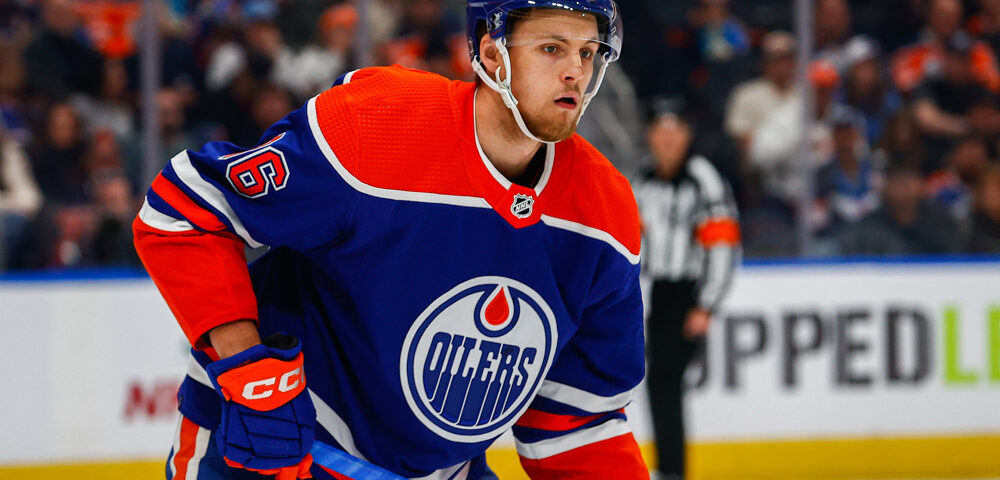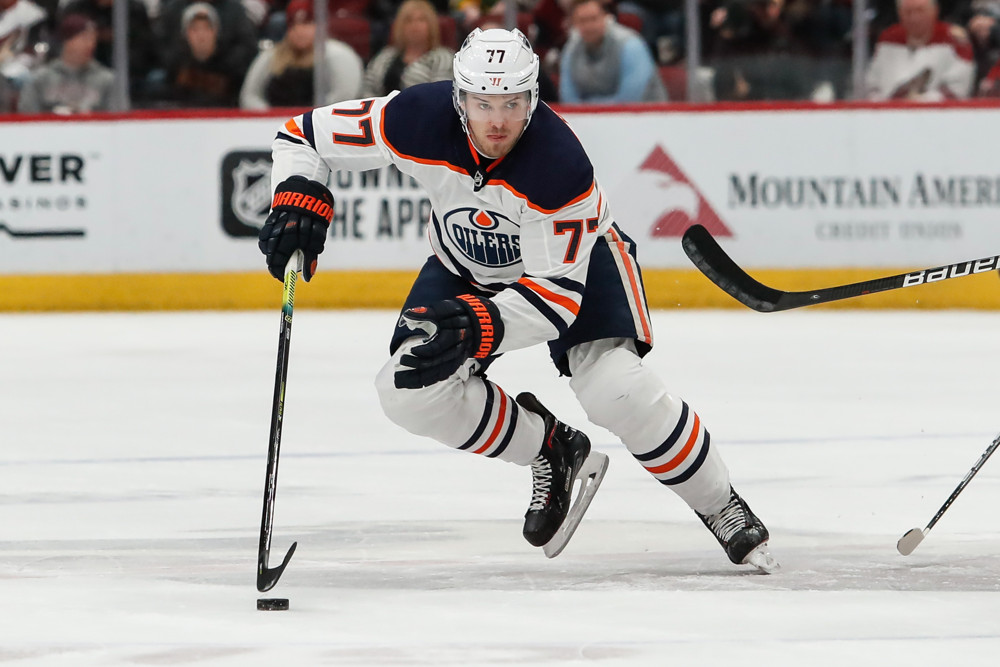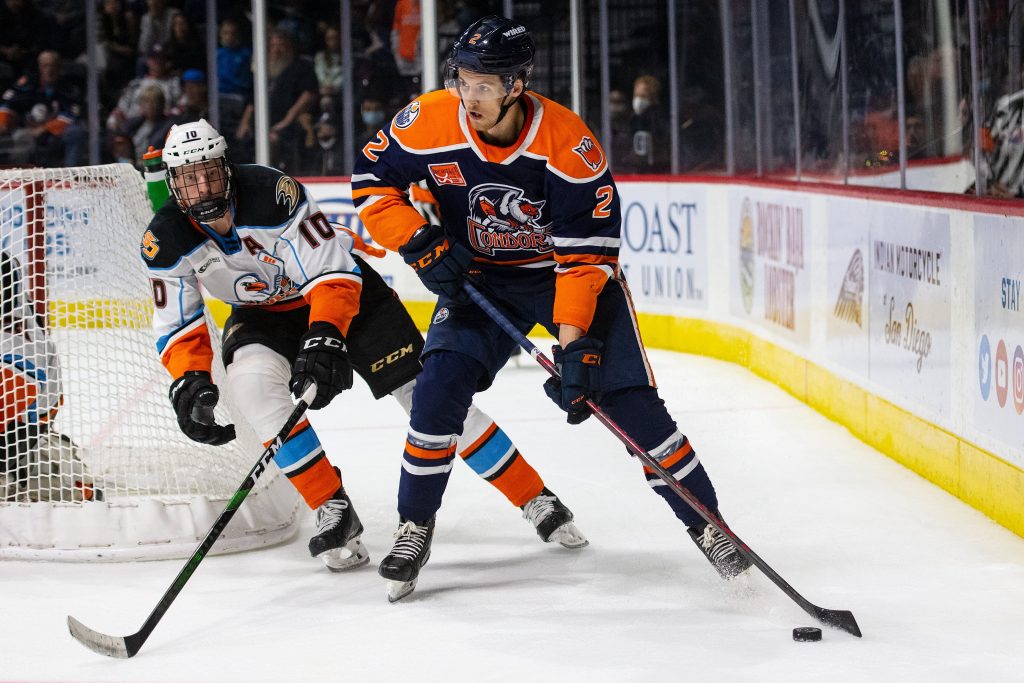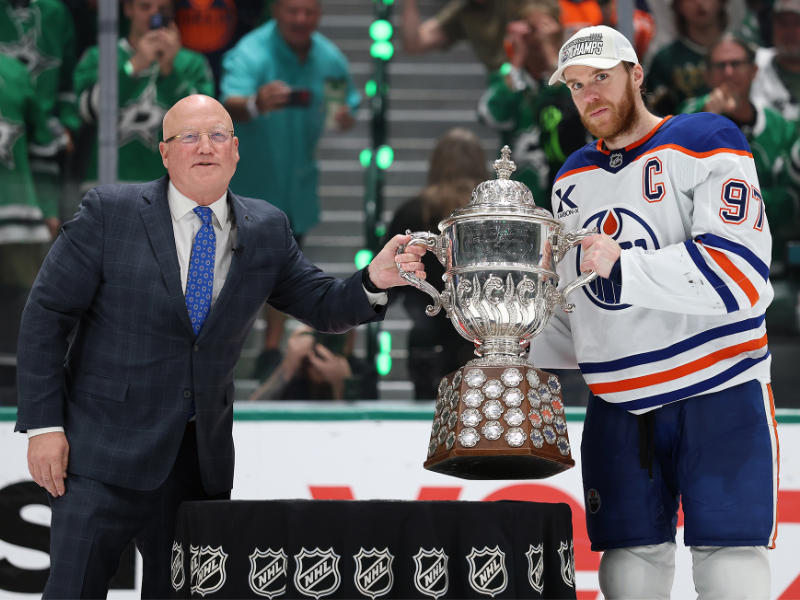
Homemade Stu – The ascent of Stuart Skinner
February 7, 2023
How Brett Kulak Has Performed in a Second Pairing Role
February 9, 2023Philip Broberg continues to compare favourably to a beloved former Oiler

EDMONTON, AB - DECEMBER 5: Edmonton Oilers Defenceman Philip Broberg (86) in action in the second period during the Edmonton Oilers game versus the Washington Capitals on December 5, 2022 at Rogers Place in Edmonton, AB. (Photo by Curtis Comeau/Icon Sportswire)
February 7, 2023 by Bruce McCurdy
Four times in the 2010s, the Edmonton Oilers invested a first-round draft pick in a defenceman. Three of those talented rearguards blossomed into productive full-time NHLers, while the fourth is making major strides in that direction.
That would be Philip Broberg, the eighth-overall selection in 2019, who follows in the footsteps of Oscar Klefbom (19th in 2011), Darnell Nurse (7th in 2013) and Evan Bouchard (10th in 2018). Broberg can be compared by the old-fashioned eye test to current teammates Nurse and Bouchard. However, by far the best comparison in terms of background, style of play, and career curve is his fellow Swede Klefbom.
I remember well my introduction to both players, each of them in high-profile international tournaments in Edmonton while wearing the gold and blue of their native Sweden. Both left a very positive first impression.
Klefbom played a single game at Rexall Place just before Christmas of 2011, a pre-tournament exhibition against Canada in the lead-up to the 2012 IIHF World Junior Championship. Already an Oilers’ prospect and therefore the apple of my eye that night, the 18-year-old was impressive on a pairing with fellow former first-round pick Jonas Brodin as Tre Kronor upset their hosts 5-3.

The Swedes then moved down to Calgary for their group and medal round games, ultimately winning gold by shutting out a high-powered Russian team, 1-0 in overtime. That remains Sweden’s only gold medal in the last 42 years, with Klefbom the team’s top out-scorer at plus-eight in the tournament.
Broberg made his first appearance here slightly earlier in the career curve, at the 2018 Hlinka-Gretzky Cup, just turned 17 and by definition undrafted. While such gifted teammates as future first-round picks Lucas Raymond, Alexander Holtz, and Jesper Wallstedt were rated as the players to watch, Broberg made an immediate impression, scoring a brilliant end-to-end goal in the tournament opener vs. Slovakia. He was strong throughout the tournament, finishing third in team scoring as the young Swedes earned the silver medal behind a powerful Canadian squad. In the process the mobile blueliner placed himself on the radar as a potential first-rounder. Little did we know then that Edmonton would be his ultimate destination.
The two Swedish blueliners overlapped oh-so-briefly in the bubble playoffs of 2020, when Klefbom, just turned 27, nursed a wonky shoulder through his final games while Broberg, 19, watched on as a member of the Black Aces. This after they had played all of 54 seconds together during the “Return to Play” exhibition game, the only time both suited up together with the Oilers.
Comparisons I – Draft year
The two are almost exactly eight years apart, each in the youngest quartile of his draft class, so year-over- year comparisons are directly on point. Let’s start with their draft day, when both were still just 17. In his recently-released book On the Clock: Edmonton Oilers at the NHL Draft, local blogger and sports radio host Allan “Lowetide” Mitchell had this to say on Klefbom:
“The scouting reports gushed about Klefbom’s passing ability and offensive instincts, along with quality foot speed. He had size, at 6’3 and 196 pounds, and had good defensive coverage along with the offensive potential scouts kept hammering.”
…and this on Broberg:
“An outstanding skater and two-way prospect, Broberg was less of a complete product (like Bouchard) and more a project with room to grow in all areas. Broberg had more risk to him but a chance to be a complete defenceman.”
When drafted, Klefbom had played 40 games against men, split between Sweden’s top league then known as Elitserien and the third-tier HockeyEttan. For his part, Broberg had played 41 games in the second-tier HockeyAllsvenskan. Both had played a full tournament for Sweden at each of U-17, Hlinka(-Gretzky), and U-18, while Broberg alone had made the World Junior team before being drafted.
As youngsters, both were long and lanky, with Klefbom ultimately filling out to 215 pounds. At 21, Broberg is still listed at 6-foot-3, 199, but surely will thicken up a bit in the years to come; indeed, there were reports he had added 12 pounds this past summer.
Comparisons II – Draft +1, Draft +2
Both players were signed to entry-level contracts by the Oilers and were loaned back to Swedish clubs, where they played both of their 18- and 19-year-old seasons before crossing the pond.
Besides his successful World Junior experience, Klefbom played 15 games of U-20 puck before graduating to the top level where he saw action in 33 games. The next season he managed just 11 games before suffering a season-ending shoulder injury that was, alas, a harbinger of things to come. Among other things, that cost him his final year of eligibility for the World Juniors.
Broberg played two full-ish seasons of 45 and 44 games, as well as two more World Junior experiences, the second of those in Edmonton as Sweden’s captain. He got banged up in the tourney, accruing a couple of “minor” injuries that would keep him out of action for a while after his return home and reportedly hamper his play down the stretch.
Comparisons III – Draft +3
Both players crossed the pond to North America at age 20. Klefbom spent 48 games with Edmonton’s top affiliate, then in Oklahoma City, posting modest totals of 1-9-10, -8. He was called up to the NHL after Nick Schultz was traded at the deadline, playing 17 games with a team going nowhere and posting 1-2-3, minus-six.
Broberg also started out in the AHL, but his (first) opportunity came quite a bit earlier in the season, Nov. 20 in fact after Darnell Nurse broke a finger blocking a shot. Duncan Keith got hurt days later, and just like that the youngster was playing big minutes, including what remains a career high of 23:44 at Vegas in just his fourth career game. He was in over his head and bleeding goals against, posting seven consecutive minus games before mercifully being returned to Bakersfield as other d-men started to return to the line-up. Early returns – one assist and a minus-eight rating in eight games – very strongly suggested “not ready yet”.

His second opportunity came in early February, when he and Markus Niemelainen found themselves on the same flight from Bakersfield to Edmonton as Jay Woodcroft and Dave Manson, themselves recalled to replace the fired Dave Tippett and Jim Playfair. By coincidence Keith had been hurt in Tippett’s last game. The new coaches’ solution was to go with a 7-man unit and spread out Keith’s ice time among several younger players. Broberg held his own, posting small numbers of 14 GP, 0-1-1, minus-one over the subsequent month before again being sent out when the Oil acquired Brett Kulak at the deadline. Bro got 2 more games after that, achieving a pair of milestones including his first career goal and his first career playoff game.
In the lower league, Broberg had a strong rookie (half-) season at Bakersfield with boxcars of 31 GP, 4-19-23, +14, playing significant minutes in all game states.
Comparisons IV – Draft +4 (through January)
Broberg is in his Draft +4 season right now, so this is where the direct comparison will have to end, at least for now. But the development curves of the two players have continued to follow parallel paths, in fact more than ever.
Both second-year pros were expected to make the big team right out of camp but encountered roadblocks that resulted in them being sent out to the AHL for a few weeks (Klefbom 9 GP, 1-7-8; Broberg 7 GP, 2-2-4) before being recalled by the Oilers in November. Their seasons subsequently rolled out in similar fashion, as per the Splits feature of hockey-reference.com.


Not much to choose there, at least in terms of boxcar stats. Interesting also that each guy found himself paired with a similar partner, young puck-moving righties with enduring questions about their defensive acumen: Klefbom with Justin Schultz, Broberg with Evan Bouchard.
The picture so far
Very interesting indeed to compare the statistics of the two players to exactly this point of their NHL careers:
Klefbom through 2015 January: 45 GP, 2-6-8, 4 PiM, -14, ATOI 18:48
Broberg through 2023 January: 47 GP, 1-6-7, 10 PiM, even, ATOI 13:30
The most interesting number to me is Games Played, reflecting how the careers of these two young Swedes remain so parallel this far out from their draft day. The boxcars too are nearly identical, both with very low penalty totals reflecting a clean style of play.
The biggest differences? Klefbom with five more minutes of ice time per night, Broberg with a significantly better goal differential. To me both of these can be explained the same way: Oscar was promoted to a much worse team with a weaker d-corps so found himself on the top four in short order, while Philip was eased in to a bottom pairing role with less playing time but more success on the goals for/against front. On balance, neither is a definitive indication that either player was “better”.
Looking ahead
From this point forward we know just Klefbom’s track record, but given their established similarities perhaps it serves as a template of how Broberg might progress in the months and years to come.
Early signs are encouraging, starting with the second half of that Draft +4 season.

Klefbom surged down the stretch, exploding for 15 points in his final 32 games after just five in his first 28. His ice time also jumped to 23-plus minutes a night, and his shots totals doubled. The plus/minus totals remained problematic, but this was a bad hockey club made worse by the deadline trade of Jeff Petry. Loading up a youngster with all the minutes he could handle made sense. That’s less likely for Broberg in 2022-23, so an eruption in scoring output seems less likely, though a spike in overall performance is certainly possible. Considering his plus-10 in January, it may have already begun.
Oilers’ GM Peter Chiarelli had seen enough through Klefbom’s first 77 games that by the following September he signed the 22-year-old to a seven-year extension even as a full season remained on his ELC. In the eyes of most, a terrific value contract, even as it all went horribly wrong in the end. (Indeed, most Oilers fans will be glad to see the last of it at the end of this season, after three years of Long Term Injury Cap Hell.)
Klefbom was a fine player in the intervening years, even as he only made it to 70 GP once in his career. That was the breakthrough 2016-17 campaign when the minute-munching Swede played all 82, posting career highs of 12-26-38, plus-7 with just six minutes in penalties.
He was still just 23 that season, his stock steadily on the rise, but he got hurt in a fateful game in Anaheim those playoffs. His shoulder was seemingly an issue from that day forward, eventually causing the premature end of a promising career.
The cautionary tale of Klefbom is that nothing is guaranteed, even when all the arrows point up. In likewise, Broberg has had his own share of injury woes in his young career, nothing catastrophic but a worry nonetheless. It’s still a point in his favour that his early career has to a large degree mirrored that of Klefbom, who remains among the very best d-men developed in Edmonton’s system in the cap era.
Ken Holland’s patience in Philip Broberg is starting to pay dividends. For all the trade talk so popular in Oil Country these days, I for one would be shocked if he were to be dealt. He’s still just 21, with another full year to run on his ELC at a bargain price. From this distance he’s a building block, not a trading chip.


1 Comment
[…] Related: Philip Broberg continues to compare favourably to a beloved former Oiler […]